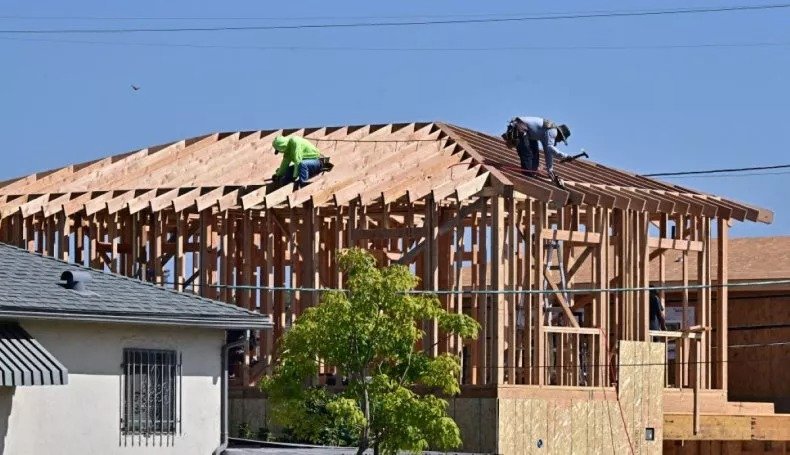Why Housing Market Trend Is 'Alarming' to Real Estate Expert
The U.S. housing market is flashing warning signs that have real estate experts concerned. A surge in unsold new homes is reminiscent of past economic downturns, raising fears of a potential recession.
Why It Matters
Homebuilders are sitting on their highest inventory levels in years. For buyers, this surplus means more choices, price reductions and builder incentives, making homeownership more accessible.
However, historically, such high levels of unsold inventory have coincided with economic slowdowns and recessions, signaling potential trouble ahead. During the Great Recession of 2008, the U.S. saw unemployment rates surge to 10 percent and the economy shrink by 4.3 percent, illustrating the potential risks of a faltering housing market.
What to Know
According to the U.S. Census Bureau, the inventory of newly built homes rose to 494,000 in December, up 10 percent from the previous year and representing 9 months of supply. When builders struggle to sell homes, it signals weakening demand, which can trigger broader economic consequences, including layoffs in the construction industry and declining consumer confidence.
Real estate analyst Nick Gerli recently took to X, formerly Twitter, to highlight a troubling trend: homebuilder inventory levels this high typically point to a recession seen five other times in U.S. history. Those periods—1974, 1981, 1991, 2008, and 2022—were marked by economic downturns, with four of those five instances leading to severe recessions and surging unemployment rates.
Gerli's post emphasized that builders are sending a clear economic warning signal. "There's only been five other times in US history where home builder inventory has been this high, relative to sales," and in four of those cases, a major recession followed, Gerli noted in his post.
Builders have been slashing prices and offering incentives to entice buyers. According to the National Association of Home Builders (NAHB), 30 percent of builders reduced home prices in January, consistent with a stable range of 30 percent to 33 percent since last July. Additionally, 61 percent of builders offered sales incentives. This trend echoes the 2008 housing crisis, when builders were forced to offload homes at discounts, further exacerbating economic strain.
However, not all experts agree that this is an imminent sign of a recession. Some experts think high housing inventory is a good sign because it fills the gap in the existing home market, boosts construction activity and meets strong demand, which builders expect will result in a robust spring market.
What People Are Saying
Nick Gerli, CEO of Reventure App, told Newsweek: "Rising builder inventory levels are a positive for homebuyers. It means more selection and the prospect of lower prices. However, from the perspective of assessing the market itself, near record-high inventory indicates that homebuilders have overbuilt, much like they did in the mid-2000s housing bubble. This is especially true in the South, which has the most new homes for sale on record, and where re-sale inventory has also started to spike. Reventure projects home prices to drop in 2025 across builder-heavy markets like Florida and Texas, which will be a positive for buyers but a negative for builders."
Alex Beene, financial literacy instructor for the University of Tennessee at Martin, told Newsweek: "The real issue is during the pandemic we had an incredible uptick in home sales in many major U. S. Markets, accelerated by low interest rates and many Americans relocating. A few years removed, houses are more expensive, interest rates have dramatically increased, and most are priced out of the market given the other sharp rises in cost-of-living expenses.
Whereas inventory was tight in many hot real estate markets just two years ago, today, buyers are likely to find many new builds on the market going unsold. And while many new home builders are trying to run interest rate promotions in the hopes of getting new buyers, the home prices themselves are still well outside of the price range needed by most to be purchased. A recession isn't guaranteed by any means, but it's easy to see why these numbers would prompt concerns."
Phillippe Lord, CEO of Meritage Homes told CNBC in December: "Inventory is definitely up across all the markets, both existing home inventory is slowly coming back and then new home construction is definitely up as well, but that's really intentional by all of us.
We still see an opportunity to fill that void by providing move-in ready inventory for all these customers that can't find that inventory in the existing home market, which is traditionally where they shop. So a lot of new home builders are building more speculative inventory to really fill that void, and we're all expecting a strong spring selling season based on what we're seeing today."
What Happens Next
The trajectory of the housing market largely depends on mortgage rates, employment trends and broader economic conditions. If rates decline, demand could rebound, helping builders clear inventory without deep price cuts. However, if rates remain high and the economy slows, builders may be forced into more aggressive discounting, potentially triggering a downturn.
For now, homebuyers may find opportunities in new construction, but industry experts warn that this inventory surge could be a harbinger of economic turbulence ahead. Real estate professionals are watching closely as the market navigates these uncertain waters.

